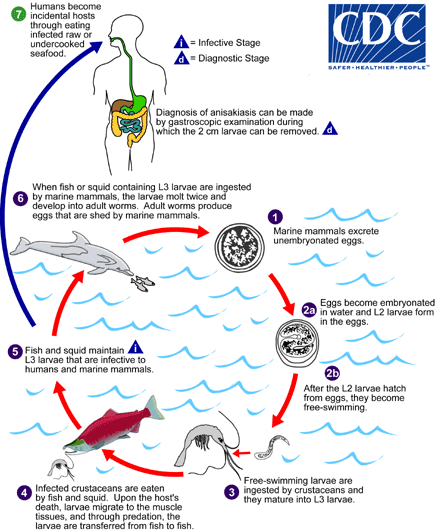Biology
Causal Agent:
Anisakiasis is caused by the accidental ingestion of larvae of the nematodes (roundworms) Anisakis simplex and Pseudoterranova decipiens.
Life Cycle:

Adult stages of Anisakis simplex or Pseudoterranova decipiens reside in the stomach of marine mammals, where they are embedded in the mucosa, in clusters. Unembryonated eggs produced by adult females are passed in the feces of marine mammals ![]() . The eggs become embryonated in water, and first-stage larvae are formed in the eggs. The larvae molt, becoming second-stage larvae
. The eggs become embryonated in water, and first-stage larvae are formed in the eggs. The larvae molt, becoming second-stage larvae ![]() , and after the larvae hatch from the eggs, they become free-swimming
, and after the larvae hatch from the eggs, they become free-swimming ![]() . Larvae released from the eggs are ingested by crustaceans
. Larvae released from the eggs are ingested by crustaceans ![]() . The ingested larvae develop into third-stage larvae that are infective to fish and squid
. The ingested larvae develop into third-stage larvae that are infective to fish and squid ![]() . The larvae migrate from the intestine to the tissues in the peritoneal cavity and grow up to 3 cm in length. Upon the host's death, larvae migrate to the muscle tissues, and through predation, the larvae are transferred from fish to fish. Fish and squid maintain third-stage larvae that are infective to humans and marine mammals
. The larvae migrate from the intestine to the tissues in the peritoneal cavity and grow up to 3 cm in length. Upon the host's death, larvae migrate to the muscle tissues, and through predation, the larvae are transferred from fish to fish. Fish and squid maintain third-stage larvae that are infective to humans and marine mammals ![]() . When fish or squid containing third-stage larvae are ingested by marine mammals, the larvae molt twice and develop into adult worms. The adult females produce eggs that are shed by marine mammals
. When fish or squid containing third-stage larvae are ingested by marine mammals, the larvae molt twice and develop into adult worms. The adult females produce eggs that are shed by marine mammals ![]() . Humans become infected by eating raw or undercooked infected marine fish
. Humans become infected by eating raw or undercooked infected marine fish ![]() . After ingestion, the anisakid larvae penetrate the gastric and intestinal mucosa, causing the symptoms of anisakiasis.
. After ingestion, the anisakid larvae penetrate the gastric and intestinal mucosa, causing the symptoms of anisakiasis.
Life cycle image and information courtesy of DPDx.
- Page last reviewed: March 18, 2015
- Page last updated: March 18, 2015
- Content source:


 ShareCompartir
ShareCompartir